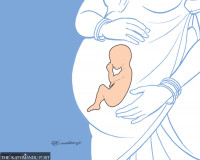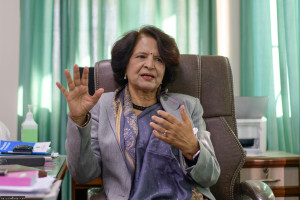Health
Senior citizens increasingly worried as they wait for Covid-19 vaccines
As 1.4 million people aged 65 and above are waiting for their second shots, there are other risk groups who need immediate vaccination, but the jabs are nowhere in sight.
Anup Ojha
Narayani Nainabasti and her husband Khagaraj had taken their first shots of Covishield, the AstraZeneca type vaccine against Covid-19, on March 12 when the government was inoculating people aged 65 and above.
It’s more than three months since, and they are wondering when they would be able to get their second dose.
“When we were given the first shots, we were told we would have to take the second dose some time after four weeks. But it has been more than three months,” said Khagaraj of Ramgha in Madhya Nepal Municipality of Lamjung district.
Khagaraj is 87 and Narayani 88.
“Now we hear from the radio and news that the government has not been able to get the vaccines to give the second dose to the elderly like us,” Khagaraj told the Post over the phone from Lamjung. “Instead of increasing the allowance for senior citizens, the government should have rather arranged for the vaccines.”
Khagaraj was referring to the recent government announcement through the budget that the monthly allowance for the elderly had been increased to Rs4,000.
The Nainabastis are among the 1.4 million elderly people aged 65 and above who were administered their first dose of Covishield in the second week of March. The government’s plan to give second doses to them, however, has gone awry. It has neither been able to get Covishield from India nor has made any progress on procuring AstraZeneca doses from anywhere else.
Maha Prasad Parajuli, president of the Senior Citizens Struggle Committee, blamed the government for not being sincere to the plight of the elderly.
“Nearly half a dozen elderly people associated with the committee have lost their lives to Covid-19,” said Parajuli. “The elderly are vulnerable to the virus.”
The government has been giving Vero Cell, the Chinese vaccine manufactured and developed by Sinopharm, to people aged between 60 and 64, but the immediate concern is about those who took the AstraZeneca type vaccine’s first dose.
Dr Janak Sharma Gautam, chief of National Immunisation Programme under the Health Ministry, said so far 458,000 people aged between 60 and 64 have received the first dose of Vero Cell.
“They will be administered the second doses from July 6,” Gautam told the Post.
There, however, is no word from government officials on when those 1.4 million elderly will get the second shots of Covishield.
Parajuli, chair of the Senior Citizens Struggle Committee, says the government's misplaced priority has exposed the elderly to more risks.
“First we need to survive to receive government allowances,” said Parajuli. “As we are hearing about the third wave of the coronavirus, we are worried.”
Nepal managed to escape the first wave of the coronavirus somewhat unscathed compared to other countries, including those from the West. The most affected ones, however, were the elderly people.
Exactly a year after the country reported its first coronavirus case, Nepal launched its vaccination drive on January 27, 2020, to the surprise of many. Prime Minister KP Sharma Oli even announced that the government would vaccinate all eligible citizens “within three months”. But the vaccination campaign hit a roadblock, as the Serum Institute of India, the world’s largest vaccine manufacturer by volume and the manufacturer of the Covishield vaccine, expressed its inability to supply 1 million doses for which Nepal already had paid.
And in April, the second wave hit Nepal, immediately after India.
Experts and observers have said the Oli administration’s inaction, foreign policy failure and the political turmoil added to Nepal’s vaccine woes.
Unlike in the first wave, the second wave did not even spare the young ones. Now as the country stares at the third wave, with a more lethal Delta variant circulating, everyone is at risk.
Experts say the elderly are obviously more vulnerable to the virus, that’s why they were a priority group.
According to data from the Ministry of Health, as of Tuesday, the number of those over 60 years who lost their lives to Covid-19 stood at 4,854. The country’s Covid-19 death toll as of Wednesday stands at 9,112. Close to 6,000 deaths due to Covid-19 were reported during the second wave.
According to the 2011 census, there are around 2.1 million Nepalis aged 60 and above.
For senior citizens, policies in Nepal have never been friendly, said Parajuli, the chair of the Senior Citizens Struggle Committee, which has over 6,000 active members.
“And Covid-19 has put them at additional risks,” Parajuli told the Post. “The government must arrange for the second dose for the 1.4 million elderly and work on a war footing to inoculate others. Yes, it should also make sure that more and more people from all age groups are vaccinated at the earliest.”
In total, Nepal needs to vaccinate around 22 million, including the elderly, of its 30 million population. With the government’s failure to act on time to procure vaccines, it has become uncertain when people could be inoculated. Chances of getting vaccines from India faded in March when the second wave slid into a devastating crisis. The Oli government, however, did not make any efforts to reach out to China, which so far has provided 1.8 million doses of Vero Cell under grant assistance, to buy the vaccines under commercial deals. Though the government says it is planning to buy 4 million doses from Sinopharm, the company’s proposal for a non-disclosure agreement to sell its vaccine has created confusion.
Hopes to get vaccines, especially the AstraZeneca type, from COVAX, an international vaccine sharing scheme backed by the United Nations, were also dashed when it said it was facing delays in supplies.
A scrambling government in April reached out to Johnson & Johnson and Moderna to explore possible commercial deals with the two American vaccine manufacturing companies.
But according to the Nepali embassy in Washington, DC, both have expressed their inability to sell vaccines to Nepal before 2022 given their supply chain constraints and prior commitments to other countries.
There were talks about Nepal importing Sputnik V from Russia, but officials say there has been no progress in that regard.
According to the World Health Organisation, although all age groups are at risk of contracting Covid-19, older people face significant risk of developing severe illness if they contract the disease due to physiological changes that come with ageing and potential underlying health conditions.
Since older people don't have as strong an immune system as the younger groups, they are more vulnerable to infectious diseases. The elderly people are also more likely to have conditions such as heart, lung and kidney diseases or diabetes, which weaken their body’s ability to fight an infectious disease.
Some social reasons also put the elderly at more risk. They might face isolation or mobility challenges or they could be living with family or a crowded situation which increases the risk of infection.
“During the second wave, we saw that people from all age groups have been affected. But there is no denying that the older population is more at risk,” said Dr Sher Bahadur Pun, chief of the Clinical Research Unit at Sukraraj Tropical and Infectious Disease Hospital. “If they have preexisting conditions, the coronavirus infection can be fatal. Apart from the 1.4 million eldelry people who are yet to get the second dose, there are many who have not got their first dose. The elderly must be the government’s priority.”




 5.27°C Kathmandu
5.27°C Kathmandu.jpg)














